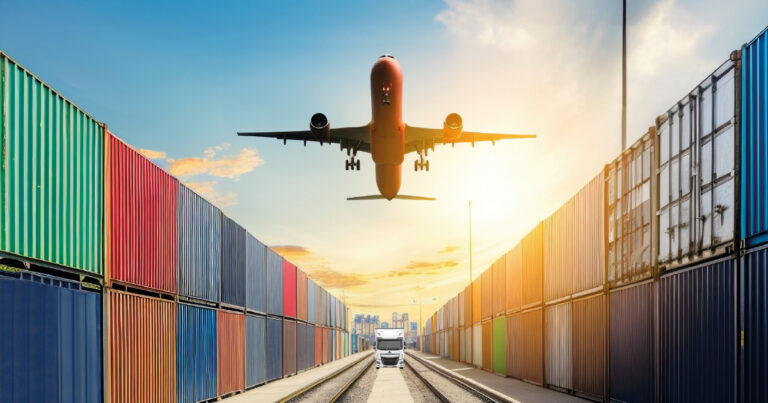Africa Market Trends: Strong Growth Despite Tariff Tensions
In the first half of 2025, Africa demonstrated remarkable performance, driven by widespread growth in maritime freight imports. Sub-Saharan Africa particularly distinguished itself with a 14% increase since the beginning of the year, fueled by significant volume increases from Asia and North America, each progressing by more than 20% according to Container Trade Statistics. The Asia-Africa route remains the most dynamic, driven by exports of manufactured goods and equipment, followed by the North America-Africa route showing strong growth, particularly in the food and pharmaceutical segments. The Europe-Africa route, meanwhile, remains stable but suffers from geopolitical tensions and high logistics costs.
“The Europe-Africa trade lane is expected to remain stable in the short term, despite a tense geopolitical context and high logistics costs. The China-Africa route maintains strong momentum, with a slight contraction in volumes expected in October due to Golden Week, which should be offset by the year-end seasonal peak. Meanwhile, the strong growth in trade between North America and Africa is explained by a catch-up effect on historically low volumes, as well as diversification toward industrial and technological equipment, illustrating the continent’s rise in its economic modernization trajectory,” highlighted the AGL freight procurement department.

The air freight sector experienced more contrasted developments. According to IATA, the second quarter was marked by a significant decline in demand, with a year-on-year decrease of 13.4% in March, despite capacity increasing by 10.5%. In particular, export volumes to the United States have declined as a result of the introduction of new customs duties. This trend continued in May with a 2.1% decline, affected by rising energy costs and geopolitical tensions. However, July marked a strong rebound with 9.4% year-on-year demand growth, the best result since August 2024. This recovery was driven by the Asia-Africa route (+12.1% year-on-year), stimulated by intensifying trade exchanges and falling jet fuel prices (−9.1% year-on-year).
“In air freight, the increase in US tariffs on Chinese products has redirected flows to Asia-Europe and Asia-Africa routes. There has also been an impact from the increase in the capacity of the air fleet between Asia and Africa operated by Ethiopian airlines companies through the expansion of the cargo hub in Addis Ababa, but also mainly Emirates and Qatar Airways,” explained the AGL Freight Forwarding’s director
Meanwhile, ground transportation is gaining ground. In South Africa, road and rail freight is asserting itself against air and maritime modes, primarily due to rising costs and logistics inefficiencies. Indeed, air freight costs can be up to 5 times higher than road transport for equivalent distances, while port delays result in delivery times exceeding 7 days mainly due to Red Sea rerouting, compared to 24 to 48 hours for road transport.
Rail is benefiting from massive investments in infrastructure modernization. In August 2025, South Africa announced the opening of portions of the Transnet network to private companies, a reform expected to enable the transport of an additional 20 million tons of freight per year from 2026/2027. The goal is to reach 250 million tons per year by 2029, with a potential increase of 10 million tons in coal exports.
“It is in this context that the MSC Group recently was granted a rail operator licence (Train Operating Company), alongside ten other companies, including Grindrod Group, African Railway Co and Menar. This authorisation allows MSC to invest and operate on six strategic corridors in South Africa, covering both mining and container routes, strengthening its presence and position in the South African market. » added the AGL Head of Rail Operations and Development
In Kenya, the rail sector is also experiencing significant advances with the launch in March 2025 by KRC (Kenya Railways Corporation) of a fleet of 16 refrigerated wagons capable of transporting 32 refrigerated 20-foot containers between Naivasha/Nairobi and the Port of Mombasa via the SGR (Standard Gauge Railway), thereby strengthening the logistics chain for perishable goods. Port-rail intermodality is also developing, as illustrated by the launch of construction work on a link between Burundi and Tanzania or the Trans-Kalahari railway project between Botswana and Namibia. Road corridors are strengthening thanks to customs facilitations promoted by AfCFTA: the Walvis Bay Corridor Group recorded nearly 2.5 million tons of cross-border flows, particularly stimulated by Copperbelt mining production.
Behind this promising momentum, however, looms a shadow: that of geopolitical uncertainties. On August 1, 2025, President Trump announced new US customs duties on African exports, which came into effect on August 7. With just hours remaining before the scheduled expiration of AGOA on September 30, 2025, concern is growing across the continent. This new protectionist policy directly threatens this mechanism that had previously allowed thousands of African products duty-free access to the US market.
South Africa, Africa’s leading exporter to the United States, faces the highest tariff (30%), affecting the automotive, agriculture, textile, and wine sectors. The country fears the loss of more than 100,000 jobs according to the Central Bank Governor, including more than 35,000 in the citrus sector alone. Customs duties also hit exports of platinum, gold, diamonds, and rare minerals, vital for countries like Ghana, Lesotho, Namibia, and Madagascar. The latter sees its vanilla and textile exports hit by a 47% tax, while Lesotho, a denim specialist, faces a record tariff of 50%. Mauritius faces 40% on its manufactured products, even though some of these raw materials are essential to American industry. Faced with this situation, several countries have engaged in diplomatic negotiations to obtain exemptions, while others are diversifying their markets. Kenya, for example, is strengthening its horticultural exports to Europe and the Middle East, thanks to preferential agreements with the United Arab Emirates and the United Kingdom.
Between sustained growth and persistent vulnerabilities, Africa confirms its strategic potential in global trade, while reminding us that its logistics future will depend as much on its infrastructure as on its ability to navigate an uncertain geopolitical context.
